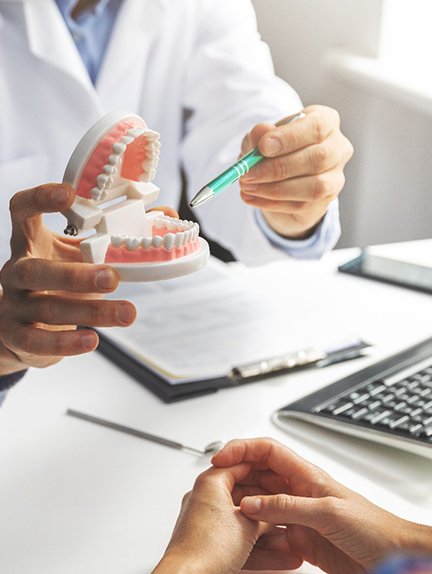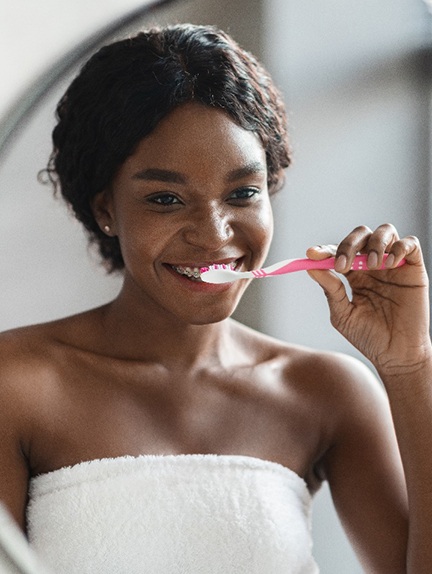A Tried-and-True Way to Achieve a Straighter Smile
Why Choose Oceanside Orthodontics for Traditional Braces?
Board-Certified Orthodontist
Personalized, One-on-One Treatment
0% Interest In-House Financing Available

How Do Traditional Braces Work?
Consisting of metal brackets that are bonded to the front surfaces of teeth as well as a metal archwire that is held in place with elastic bands and threaded through the brackets, these braces work to move your teeth and underlying bone over time.
With regular follow-up appointments every few weeks, your doctor will tighten the wire or replace it with a different size archwire to keep your smile moving in the right direction at the appropriate pace.
Based on the status of your dental issue at the start of treatment, you can expect to wear your braces, on average, for 1-2 years.
What Orthodontic Issues Can Braces Fix?

Bite Misalignment
Do your teeth not come together evenly when you bite down? Do your lower teeth sit in front of your upper teeth? If so, you should come in for a consultation with our dedicated orthodontist in Fort Lauderdale. That way, we can assess the complexity of your case, review the available treatment options, and create a custom treatment plan that will align your teeth and your bite.
Crowded & Crooked Teeth
If your teeth crowd together or are tilted out of alignment, you should come in for the necessary orthodontic care before the look, health, and function of your smile are negatively impacted. If you’re a candidate for traditional braces, then we will continuously apply just enough pressure to guide your teeth into their properly aligned positions comfortably.
Gapped Teeth
Gaps between your teeth can create problems when it comes to the health and function of your smile, which is why we encourage patients with this orthodontic issue to come in for an appointment even if they don’t mind the aesthetic drawbacks. Our goal is to bring your teeth into proper alignment before you experience any trouble with your chewing or speaking patterns.

Caring for Your Braces
Just like you need to care for your teeth, you need to care for your braces. Here are a few habits we recommend adopting:
- Brushing your teeth (and braces) after each meal
- Flossing and rinsing with mouthwash regularly
- Sticking to the dietary restrictions
- Quitting unhealthy habits, like biting your nails
- Getting a dental checkup and teeth cleaning biannually
- Prioritizing your check-in visits
Benefits of Traditional Braces
- A smile that is free of overcrowding, gaps, and crooked teeth.
- Improved oral and overall health by reducing the risk of chronic jaw pain and worn-down tooth enamel caused by misalignment.
- Improved eating and speaking habits.
- A reduced risk of tooth decay and gum disease because you will be able to brush and floss with greater ease.
- Greater confidence in your appearance.


What Are Self-Ligating Braces?
Self-ligating braces are similar to traditional braces but instead of relying on elastics to hold the archwire in place, they consist of a built-in system that uses brackets or clips that function as a gate that can be opened and closed.
There are two types of mechanisms used with self-ligating braces: active and passive brackets. The former uses a sliding spring clip that presses against the archwire, while the latter requires a sliding mechanism that doesn’t apply pressure or force.
Choosing self-ligating braces is a great option if you want to avoid multiple dental appointments and desire to maintain better oral health throughout treatment. Also, if you would rather avoid colored elastics while wearing braces, this option can be a desirable choice.
How Much Do Traditional Braces Cost?

Traditional Braces FAQs
What foods should I avoid with metal braces?
For the first few days after getting braces, your mouth will be sore and likely tender, making it uncomfortable and difficult to chew certain foods. Because of this, it’s recommended that you stick to a soft diet for the first several days, eating snacks like yogurts, smoothies, mashed potatoes, and soup. This adjustment period can last for up to a couple of weeks as you’re becoming more comfortable and used to your brackets and wires.
Even after you adjust to your braces, you’ll need to steer clear of certain foods that could dislodge a bracket or break your archwire. Our team at Oceanside Orthodontics recommends avoiding hard and crunchy foods like popcorn, sticky candies like caramel, nuts, crusty breads, pretzels, potato chips, etc. If you have a habit of biting your nails, crunching on ice, or chewing on the tip of your pens or pencils, try implementing different distraction techniques to help break them.
If at any point you do experience a broken bracket or archwire, don’t worry! This happens to virtually every patient at some point throughout their treatment. Just call our office as soon as possible so we can get you in to repair it so your treatment doesn’t get set back.
Do traditional braces hurt?
We want you to have realistic expectations for your treatment, so we’re not going to hide the fact that your mouth might be very sore the first week or so that you have your braces. However, this tenderness is only temporary and fades away with time. Additionally, eating soft foods and using orthodontic wax is a great way to curb your discomfort through this adjustment period. Just keep your eyes on the reward at the end!







